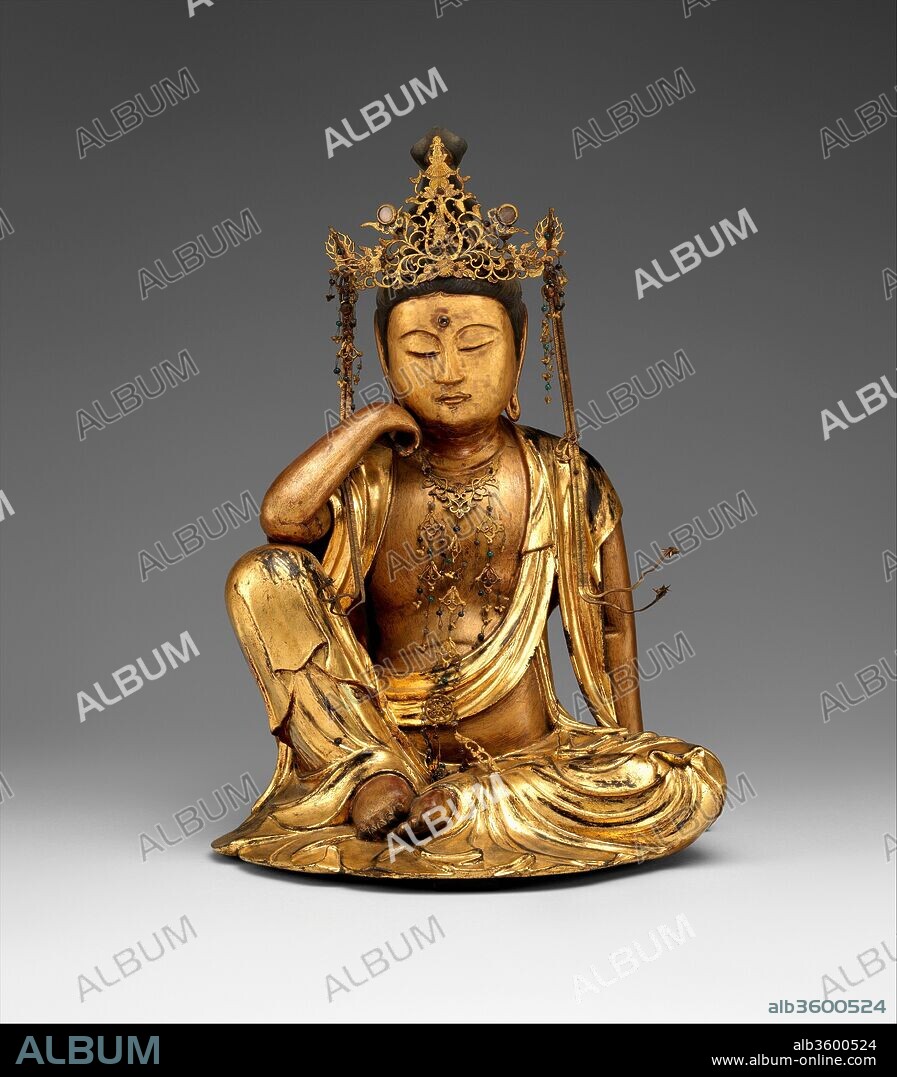alb3600524
Nyoirin Kannon

|
Añadir a otro lightbox |
|
Añadir a otro lightbox |



¿Ya tienes cuenta? Iniciar sesión
¿No tienes cuenta? Regístrate
Compra esta imagen.
Selecciona el uso:

Título:
Nyoirin Kannon
Descripción:
Traducción automática: Nyoirin Kannon. Cultura: Japón. Dimensiones: H. 16 9/16 in. (42,1 cm); W. 12 1/8 pulg. (30,8 cm); D. 10 1/4 pulg. (26 cm). Fecha: fechado en 1693. El bodhisattva Kannon (sánscrito: Avalokiteshvara) se manifiesta en muchas formas, cada una de las cuales demuestra aspectos de su compasión y votos salvíficos. Esta pequeña escultura muestra al bodhisattva en una forma Budista Esotérica llamada Nyoirin, indicando los atributos que más comúnmente tiene en sus manos, la joya que concede los deseos (nyoi) y la rueda (rin) del Dharma, o enseñanzas budistas. Mientras que muchas imágenes del bodhisattva tienen seis brazos, esta escultura tiene dos. Una inscripción tallada en la base indica que se trataba de un exvoto a un templo dado en el quinto mes de 1693. Como los nombres de las donantes indican que eran mujeres, es posible que la escultura fuera dedicada con motivo de una menstruación ritual popular en el período Edo llamado jukuya-ko, una asamblea de mujeres budistas que tenía lugar el día diecinueve del mes para la salud y el parto seguro de los niños. Muchas estelas en relieve de piedra que representan una forma de dos brazos del bodhisattva dedicado el día de este rito permanecen desde el período Edo. Los registros indican que en ese momento también prevalecía una asamblea paralela dedicada a una deidad sintoísta.
Nyoirin Kannon. Culture: Japan. Dimensions: H. 16 9/16 in. (42.1 cm); W. 12 1/8 in. (30.8 cm); D. 10 1/4 in. (26 cm). Date: dated 1693.
The bodhisattva Kannon (Sanskrit: Avalokiteshvara) manifests in many forms, each of which demonstrates aspects of his compassion and salvific vows. This small sculpture shows the bodhisattva in an Esoteric Buddhist form called Nyoirin, indicating the attributes most commonly held in his hands, the wish-fulfilling jewel (nyoi) and the wheel (rin) of the Dharma, or Buddhist teachings. While many images of the bodhisattva have six arms, this sculpture has two. An inscription carved into the base indicates that it was a votive offering to a temple given in the fifth month of 1693. As the names of the donors indicate that they were women, it is possible that the sculpture was dedicated on the occasion of a monthly ritual popular in the Edo period called the jukuya-ko, an assembly of female Buddhists that took place on the nineteenth of the month for health and the safe delivery of children. Many stone relief stelae depicting a two-armed form of the bodhisattva dedicated on the day of this rite remain from the Edo period. Records indicate that a parallel assembly dedicated to a Shinto deity was also prevalent at the time.
Técnica/material:
Wood with gold, gold leaf, lacquer, and crystal inlay
Periodo:
Edo period (1615-1868)
Museo:
Metropolitan Museum of Art, New York, USA
Crédito:
Album
Autorizaciones:
Tamaño imagen:
3549 x 4053 px | 41.2 MB
Tamaño impresión:
30.0 x 34.3 cm | 11.8 x 13.5 in (300 dpi)
Palabras clave:
ARTE ASIATICO • ASIA • BARNIZ • CRISTAL • ESCULTURA • JAPON • METAL • METROPOLITAN MUSEUM OF ART, NEW YORK, USA • ORO BATIDO • ORO • PAN DE ORO


 Pinterest
Pinterest Twitter
Twitter Facebook
Facebook Copiar enlace
Copiar enlace Email
Email
